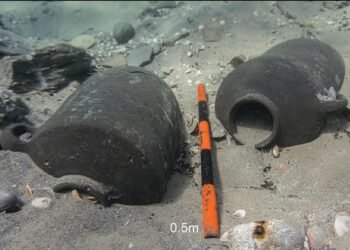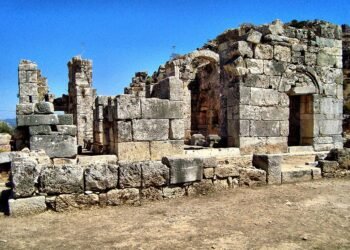A colossal step pyramid, believed to date back to the 2nd millennium BCE, has been unearthed in northern Kazakhstan’s Kyrykungir monumental complex.

The unprecedented discovery, announced by the L. N. Gumilyov Eurasian National University (ENU) on August 8, 2023, is rewriting the history of the Central Asian steppes.
For nearly a decade, a dedicated team of researchers and archaeologists has meticulously excavated the ancient site near the village of Toktamys, unearthing a trove of relics that offer a glimpse into a bygone era.
This monumental edifice, distinguishable by its hexagonal form, defies conventions, showcasing remarkable geometric precision and intricate design, unlike any other known step pyramid within the Eurasian region.
Historian Ulan Umitkaliyev, who leads ENU’s Archaeology and Ethnology Department, described the pyramid as an extraordinary architectural marvel. “The steppe pyramid is built with great precision, it is hexagonal,” Umitkaliyev stated. “There are thirteen meters and eight rows of stones between each face. It is a very sophisticated complex structure with several circles in the middle.”
Symmetry and proportionality characterize this monumental pyramid, with each of its six sides measuring approximately 42 feet in length. The pyramid’s meticulous craftsmanship speaks to the ingenuity of its ancient builders, whose visionary skills have been showcased through its enduring stone construction.
Adorning its exterior walls are depictions of various animals, most notably horses, which have held a prominent role in the region’s history. The presence of horse bones near the pyramid implies a connection to an ancient horse-centric cult.
Beyond its equine associations, the step pyramid has unveiled a treasure trove of artifacts. Among the discoveries are fragments of ceramics, intricate gold women’s earrings, and a myriad of other jewelry items. These findings underscore the pyramid’s role as a hub of cultural expression, reflecting its status as a center of ancient Bronze Age culture.
A cross-section of the pyramid. Credit: Kazakhstan’s Ministry of Science and Higher Education
The Kyrykungir monumental complex, situated around 420 miles southeast of Astana, the capital of Kazakhstan, has been the focus of extensive excavations since 2014. The ongoing efforts have unveiled sepulchral hillocks dating back to the Hun and Saka periods, showcasing the diversity of cultural influences that converged within the region.
The discovery of this enigmatic step pyramid serves as a reminder of the pivotal role played by the Eurasian steppe during the Bronze Age. This historical period, spanning from 3300 BCE to 1200 BCE, marked a significant epoch characterized by the widespread use of bronze for tools and weapons. The steppe’s extensive expanse facilitated trade, cultural exchange, and the movement of people, contributing to the rise of nomadic and semi-nomadic cultures that thrived on pastoralism and horse domestication.
As excavation efforts continue, students from the university, along with international researchers, are joining forces to delve deeper into the pyramid’s secrets.
(This article is based on information from multiple reliable sources)
























That looks like a makeshift lame attempt to make any kind of pyramid by anyone. Poor design and materials IMHO.
Alright Kevin, great opinion.